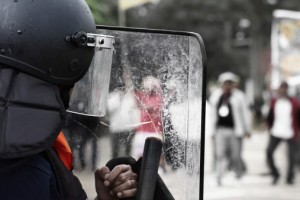By Stephanie M. Hunziker, PhD, criminal justice faculty at American Military University
No one can condone the violent actions and civil unrest happening in Baltimore, which has forced the city to activate the National Guard. The death of Freddie Gray—who appears to have died from a broken neck that was sustained while in police custody—has angered citizens because it represents the city’s history of poor police-community relations. Baltimore is just the most current example of similar anger being felt and expressed in cities across the country.

[Related article: How to Manage Stress Levels During Lawlessness and Mob Situations]
The Real Story Behind the Violence
This anger has been building for many years in Baltimore. There are known issues in the Baltimore Police Department. In October 2014, the U.S. Justice Department began its own investigation of the department, months before the Freddie Gray incident.
In September 2014, Mark Puente wrote an in-depth article in The Sun about police brutality. In this article, he noted that between January 2011 and fall 2014 there were more than 100 judgements and settlements in favor of plaintiffs who had been subjected to undue force by the Baltimore police. The city paid almost $6 million to victims in cases involving excessive force by police.
The True Costs to the Community
The costs to the city are much greater than any monetary figure. As a result of the use of excessive force, citizens distrust the police. They are frustrated that, instead of being protected by the police, they may become the victims. The anger and frustration with the law enforcement community has now bubbled to the surface and is in the public eye for all to see. These are not new lessons. The President’s Commission on Law Enforcement and Administration of Justice in 1968 noted that “a community’s attitude toward the police is influenced most by the actions of individual officers on the streets” (p. 262).
[Related article: Need for Strong Community Relations Among the Lessons of Ferguson]
Recovery Efforts
In this situation, it can be very hard for citizens to keep in mind that the vast majority of police officers are honest, ethical, and hard-working. It only takes a few officers abusing their power and violating the rights of citizens to make all law enforcement seem corrupt. What did Freddie Gray do when he saw police officers looking at him? He ran. Was it due to his numerous prior arrests for drugs and other offenses? Was he afraid? We will never know the answer as to why he ran.
[Related article: Use of Deadly Force on Fleeing Criminals]
The systemic issues and root causes do not condone the violence and rioting happening right now in the streets of Baltimore. It is plain wrong.
However, while many of the citizens of Baltimore are engaged in peaceful protest, others are acting out and exploiting an opportunity. The good citizens of Baltimore feel helpless and voiceless while a lawless element captures the media’s attention. While there is no doubt that this violence must be quelled, the law enforcement community must also recognize that there is hard work ahead to re-build community relations and restore faith in their officers.
[Related article: Facebook: A Tool Police to Restore Community Policing]

Comments are closed.